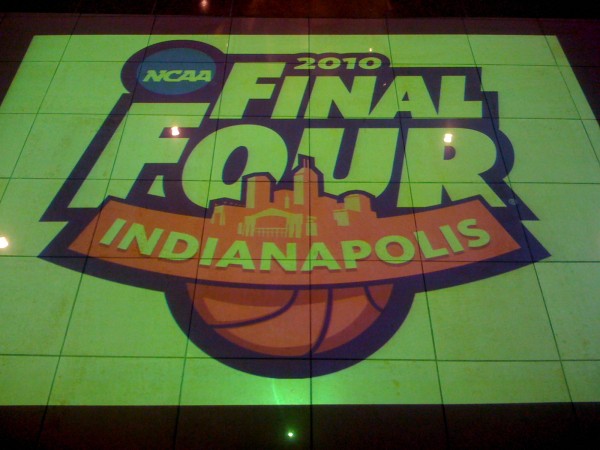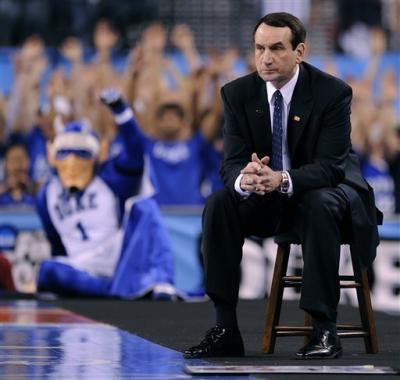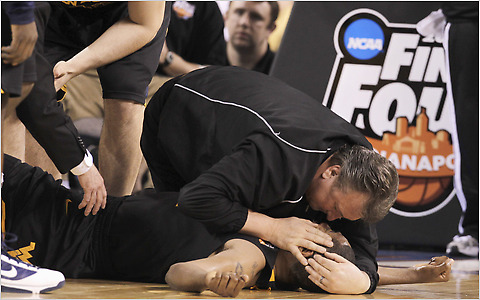Selected Thoughts From Final Four Weekend
Posted by rtmsf on April 8th, 2010You know how this works… here are some random thoughts bouncing around our head as we come out of a pretty damn good Final Four in Indianapolis.
Coach K is the Current Dean of Coaches. But let’s get one thing put to rest right away. He’s not John Wooden. For all you presentists out there convinced that the era we’re currently in is tougher than any other previous one, get your head out of your sphincter. Make all the excuses you want, but Wooden beat all comers west AND east, year after year after year after year (ten times in twelve seasons). We could go on and on about this, and if the numbers were anywhere near each other (like if K had eight titles to Wooden’s ten), we’d entertain the argument. But they’re not, and Coach K would probably be the first to chastise you of such foolishness. Now, with that said, Krzyzewski is a clear #2 all-time with his most recent title. Tom Izzo came into the Final Four with everyone gushing about his six appearances in the last twelve years, but it’s K who has done it better for longer, now with eleven F4s and four national championships to his credit. Whenever he decides to retire, and there’s a good chance it won’t be for another decade, Coach K will have far surpassed the man whom he set his eyes on as a target way back in the early 80s — UNC demigod Dean Smith. What seemed like a herculean impossibility at that time ultimately came to pass, as Coach K is now the Dean of Tobacco Road and the Smith family tree of he and Roy Williams must combine championships at UNC to simply match those of K (something undoubtedly not lost on Williams in his lair at this very moment). Furthermore, Krzyzewski proved with this year’s team that he doesn’t have to have better talent than everyone else to cut down the nets — his other championship teams were stacked to the brim with future pros, but it will ultimately be the 2010 national titleist that raises his legacy from one of the coach with the best talent to one of the talent with the best coach.
Greatest Title Game Ever? Had Gordon Hayward’s half-court shot found net, we’d be on board with this. The storyline is just too good. Even better than Villanova taking down big, bad Georgetown in ’85 or NC State’s miracle of miracles two years earlier. The Jimmy Chitwood/Bobby Plump comparisons would have been endless, and we’re a little more than halfway convinced that we’d have seen our first-ever title game RTC should the ball have gone through. Unfortunately for most of America, like many life-story endings awkwardly forced into a Hollywood template, reality leaves you waiting for the next moment that never comes — the Hayward shot didn’t magically bounce up in the air and fall back through… The truth is that the national championship game was a hard-nosed, calculating, defensive-minded drama between two teams where every single point came with a price tag. But it wasn’t beautiful, and in order to have greatness bestowed upon a game, it usually needs to end with a make rather than a miss. This is not always the case, but it’s difficult to buy into the GOAT argument when the last made field goal occurred with just under a minute remaining (as a comparison, the widely-accepted greatest game of all-time, 1992 Duke-Kentucky, had five lead changes in the last 35 seconds of overtime). So where does it rank? Still pretty high — for our money, this was the best championship game since 1999 UConn vs. Duke (yes, Memphis-Kansas was thrilling, but not for the entire game), and is definitely in the top 6-8 in the post-Wooden era, but let’s keep our wits about us here.
People Will Come, Ray. People Will Most Definitely Come. Mixing metaphors between sports, we found it interesting that the Duke-Butler national title game drew the highest television ratings (14.2) for a championship since 2005’s classic between UNC and Illinois. This amounted to nearly 48 million Americans tuning into the game at some point during the broadcast, which is the highest aggregate total since 1997 (Kentucky vs. Arizona). Considering that several traditional powerhouses (UNC, UConn, UCLA) weren’t even invited to the Dance, what can we draw from this? For one, Duke and Cinderella sell, showing again that casual fans do not need marquee stars such as John Wall or Evan Turner to find a reason to watch a compelling collegiate matchup. To paraphrase Vitale who has crowed about this forever, college basketball really is still about the names on the front of the jerseys rather than the backs, and people clearly enjoyed rooting against Duke and pulling for the unknown kids from Butler on Monday night. Crazy to consider but probably true, as much as we’d like to think a Kansas-Kentucky final would have been the preferred matchup, it’s doubtful that casual interest for that game would have been as high. Another thought, given that Tournament ratings were up 5% across the board this year, is to realize just how important opening weekend buzz is for the shelf life of the Tourney. If there are no great finishes and upsets, then many casual viewers are lost early, never to return. This is something that the NCAA should consider very carefully when making a determination on whether two days of expanded first round #9 vs. #24 games are good enough theater for the interst of casual fans. To someone tuning in only for March Madness, it doesn’t mean anything to him if #9 UNLV loses to #24 Morgan State, but he easily recognizes the gravity if that same #9 UNLV team beats a #1 seeded Kansas two rounds later. Put in terms the organization can understand better, what does the NCAA stand to lose by moving the Round of 32 to a random Tuesday/Wednesday when many of the biggest and best upsets happen (see: Northern Iowa over Kansas and St. Mary’s over Villanova)? Will those March-only fans still be as interested at that point or will fatigue of four days of early-round games have already set in by the time the best matchups occur? We think that these are the hard questions that the NCAA needs to ask itself and be sure about its answers before moving forward with expansion.
Da’Sean Butler’s ACL Injury. Butler’s ACL injury on Saturday night was a truly heart-wrenching moment for the charismatic forward who represented so much of the hard work, toughness and swagger that Bob Huggins has brought to Morgantown. But it also brings up as a bitter reminder the reason that many players who are projected as first rounders in the upcoming NBA Draft need to give it a long, hard look. Let’s be clear — Butler was never going to be a lottery pick in the eyes of the scouts, so it’s not as if he personally turned away guaranteed millions in previous summers, but the lesson learned is that as much as we hope and want players like Kyle Singler, Gordon Hayward and others to consider staying in a college uniform for another year or two, a single play like the one Butler suffered in the national semifinal can severely damage a player’s livelihood. As an example of the devastating impact of a knee injury, Butler went from a probable late first rounder to a possible second rounder as a result, and you really hate to see it in the case of a player who did everything the right way throughout his college career. If we know anything about the character and moxie of this particular player, though, we expect we’ll see him work his way up through the NBDL into the NBA a year or two from now.
Next Year For These Four. If Kyle Singler and Gordan Hayward stick around, it’s safe to say that both Duke and Butler are going to be even more loaded than this year. The defending champs will add superstar point guard Kyrie Irving to replace Jon Scheyer and Seth Curry will become eligible after his transfer year. You’d expect that the Plumlees will be able to provide what Brian Zoubek did for the team this year, and of course Coach K is still over there on the sidelines. Butler keeps everyone except Willie Veasley and Avery Jukes (who was so clutch in the first half on Monday night), but the biggest question mark for the Bulldogs is what, if anything, Brad Stevens will do. If he sticks around, Hayward probably will also, and the Bulldogs will enter 2010-11 as a top five team. As for Michigan State and West Virginia, it’s the Spartans who are in greater shape for next season, losing only Raymar Morgan and keeping everyone else of consequence. Don’t be surprised when MSU loses a few early games and everyone forgets about them by March, only to see Izzo put it together again for yet another Final Four run next season — the talent is there. WVU is another team with a significant amount of production returning, as Bob Huggins loses only Da’Sean Butler and Wellington Smith from a team that you know will defend and rebound their way to another solid campaign. After most seasons, you expect to see a bunch of Final Four players jumping ship to the NBA, but in this year’s star-less event, each of these teams could come back as good or better than they were in the 2009-10 season.














































Wooden had an amazing career, duly praised as the best ever. That’s mo reason not to face the truth; his teams were enormously advantaged by the system in place at the time. The early UCLA years featured a cruise through a weak, weak West regional, the era where conferences sent more than 1 representative (so that top 5 teams from conferences with strength and depth sometimes didn’t go to the tourney at all) only ended a few years before the end of the Wooden era, and real seeding didn’t begin until after his career was over.
No way he wins 10 under modern rules.
Here’s the actual story and stats in the 10 UCLA championship years. Note, for example, how many years they got all the way out of the West regional (and thus to the final four) by playing either the 16th ranked team, or the hapless Long Beach State Tarkanians, or both? Several representative trips to the finals:
67 – beat no rank and 16th ranked Pacific
70 – a twofer, beating 19th ranked Long Beach, then 16th ranked Utah State
71 – another twofer, beating Long Beach State ranked (yes!) 16th
72 – beating LBS, ranked 5th that year, but the same old Tark run and gun crowd
73 – beat 16th ranked Arizona State, then 20th ranked San Francisco
This excludes 68 (beating nr and 12th), 74 (beating 20th before losing to NC State Wolfpack). Even their 69 meeting with #3 Santa Clara (a 38 point beatdown) was against an opponent which had run up a gaudy record against nobody.
It gets worse; for almost the entire run, the ‘regional’ setup meant they played the midwest winner in the semis, tuning up against the usually hapless mid-west winner (notable exception, Houston) while the survivors of the east and mideast ground each other to a pulp.
Bottom line, for many of the 10 years (arguably 8), they were given a slide, not just to the Final Four, but to the final game.
Meanwhile, back in the utterly brutal East. 67 (UNC 4, Princeton 5, St Johns 12, BC 8), 68 (UNC4, St Bonnies with Lanier 3, Davidson (Malloy et al) 8, Columbia (McMillan) 7). No chance any of those guys would have tested UCLA? (I don’t recall Kareem dominating Lanier in the NBA, just for starters). 69 (4, 5, 8, 9). In 71, as UCLA tunes up with only 16 LBS in the West, the East (3,6,9,18), Mideast (2,7,8,10), and even the Midwest (4,12,14,19) were all tough.
I’m not remotely arguing the Bruins weren’t great, I have eyeballs, and my memory ain’t that bad. But 10 for 13, with no footnote, no asterisk? I don’t think so. Most folks have forgotten how the NCAA was set up back in the day (if they were old enough to know). Ain’t so, and there’s no way they win 10 without that setup. Enough times out of the chute, and upsets happen.
Want to make the argument they would have won all of them in, say, the Alcindor years? Maybe. But was the Alcindor team better than the Walton team, which lost to the Wolfpack
I think they win 5 or 6 with a straight setup, no more.
Figured this would come up. Here’s my response.
67 – easily defeated Houston and Dayton to win the title. There was no team anywhere better than this team. That’s two.
68 – destruction of Houston and UNC to win title. Again, no question ANYWHERE who was the best team. Three.
69 – the semifinal against Drake was close, but COME ON, they beat Purdue by twenty in the championship game. How is this arguable. Four.
70 – two more double-digit wins against the F4 opponents. Five.
71 – eight and six point wins in the F4 – the closest it’s been in the run. Does that make them less of champion? Six.
72 – destruction of Louisville followed by a close win over FSU. We’ll even give you this one. Still six.
73 – two more dominant wins, including 21-22 from Walton. Seven.
75 – obviously, the streak ended in 74, and these were two close wins. Take them away if you like. Asterisk them. That’s still seven in nine years. Nobody else has even come close.
Here’s the problem with your analysis, and it’s a MAJOR problem. UCLA was the best team in America every single season from 1967-73. They also won the title in every one of those years. To win the title, it takes more than an easy road and luck. It takes talent and skill and the ability to win under pressure. I refuse to dismiss the single most dominant run in the sport (actually, almost ANY sport) due to simply an “easier” road to the F4. It’s on its face ridiculous and you know it is. They were the best team in every one of those years and they proved it by (most years) easily winning the title. For Chrissakes, they won 88 games in a row at one point, and that included wins against teams back east along with the western teams.
So I say, go ahead and take away a couple of the titles. Make it eight. Still the best ever, and it’s not even close. You said 5 or 6, which is patently absurd, but you know what — still the best ever, and it’s not even close. So it really doesn’t matter. You might as well start arguing that UCLA would have never won 10 in 12 years with 1-and-done players (which is probably true), but is that something that matters to anyone now? Does it make the titles less valid? Just because it’s done differently now invalidates Wooden’s achievements?
“Just because it’s done differently now invalidates Wooden’s achievements?”
Invalidate it? No. But it simply isn’t the same. Winning 4 games, two of them against mediocre competition, isn’t the same as winning 6 games (albeit often with two against mediocre competition).
Your argument is based on the fact that UCLA was clearly the best team in the country for, say 7 of their 10 championships. No argument there. But if you look back over the past ten years, how many times has the “obviously best” team in the country won the championship? And, I think you would have to admit, the last decade has been a pretty “chalky” era. You can make the argument that the difference is that Wooden was coaching, but I think that in the modern NCAA tournament, the field will always have a huge advantage over the favorites, even if there is a dominant team.
DMoore, I think you’re making a fallible comparison in looking at any of the last decade’s “best” teams vs. those UCLA teams. Those UCLA teams were so much better than the rest of America in most of those years that it was literally like putting NBA talent up against NCAA talent. They lost a total of five games in seven years, and I cannot believe that was a result of weak scheduling and/or an easier road to the Final Four.
88 games in row! When Notre Dame finally beat them in 1974 it was as if the world had ended. The closest thing we’ve seen to that kind of dominance has been the UConn women’s team, and it’s simply not fair. Nobody can touch that team any more than anyone could touch those Wooden teams. They had better talent, better coaching and an understanding of how to win.
I get a little tired of hearing modernists trying to minimize the Wooden era by comparing it to the modern era. The fact of the matter is that those teams were absolute juggernauts, and I seriously doubt they were going to lose any of those ten championships under any system you could devise (unless you made players like Alcindor, Hazzard, Walton, etc. play with their weak hands, haha).